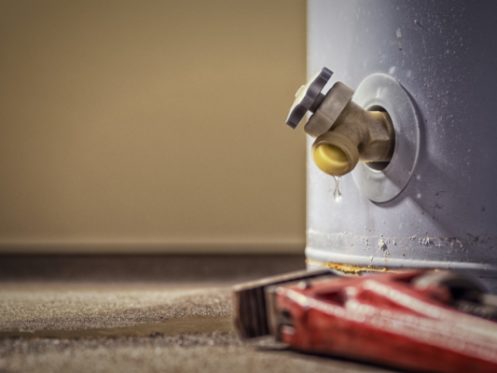Many traditional water heaters rely on a standing pilot light to work. The pilot has a constant flame that is used to ignite natural gas whenever the unit needs to heat water. When the pilot light goes out, the unit won’t work until you relight it. This isn’t something that you should really ever have to do except if you turned the water heater off or the gas went out for any reason. However, there are times when a strong draft of wind can blow the flame out and cause you to have to relight it. If you’re not familiar with how this is done, here is a full overview of how to relight your water heater’s pilot light.
Types of Pilot Lights
If you have a newer water heater, there is a good chance that you won’t ever have to worry about the pilot light. Many newer units don’t rely on a standing pilot light with a constant flame and instead use some other type of ignition to light the gas.
The most common type is an intermittent pilot. This is similar to a standing pilot in that it still uses a flame to light the gas. However, the difference is that the unit automatically lights the pilot on its own whenever necessary. This means that there is no standing flame and the pilot is only lit when the unit is heating. As soon as the water heater completes its heating cycle and shuts off, the flame automatically goes out.
Other water heaters have a direct-spark ignition, which doesn’t require a pilot flame at all. Instead, this type of ignition system produces a spark that ignites the gas. This is basically the same as the spark that you use to ignite a standing pilot light or most gas barbecue grills.
Some units rely on hot-surface ignition. This type of ignition uses a thin metal probe similar to a filament in a light bulb. When the water heater needs to turn on, it sends electricity flowing through the probe. Within a few seconds, the probe becomes glowing hot and produces so much heat that it instantly ignites the gas flowing over it.
Understanding the Parts of a Pilot Light
Before looking at how to light your pilot light, it’s first important to understand the different parts. This will help if you can’t get the pilot to stay lit and need to troubleshoot the problem. Close to the bottom of the water heater or inside an access panel you’ll find the gas control knob and electric igniter button, which are used when lighting the pilot.
If you look inside where the pilot flame should be, you’ll see a thin tube and a small metal probe. These are the pilot tube and thermocouple. The pilot tube works to supply the small amount of gas needed to light the pilot flame and keep it lit.
The thermocouple is an important safety feature that detects when the pilot is lit. The thermocouple controls the gas valve and will only open the valve when the pilot is lit. If the pilot isn’t lit, the thermocouple will keep the valve closed and no gas will flow to the unit. There can also be times when the thermocouple doesn’t properly detect the pilot flame, and this can prevent the pilot from staying lit.
Lighting the Pilot
Before trying to light the pilot, you will first need to turn the gas control knob to the “Off” position and wait at least five minutes. This allows any latent gas to dissipate, which is important as this can prevent the pilot from igniting.
After five minutes have passed, you will want to turn the control knob to the “Pilot” setting. You will then need to press and hold the knob in as far as it goes. Depressing the knob opens up the pilot tube and allows gas to flow. With the knob held in, use your other hand to repeatedly press the igniter button until you see a flame. You should see a small spark each time you press the button. If you don’t see a spark, you will need to manually light the pilot with matches or a long-handled lighter.
Once the pilot flame is lit, you need to continue to keep the control knob depressed for around 30 seconds. You can then release the control knob and see if the pilot stays lit. If the flame goes out, you will need to again turn the knob to “Off,” wait five minutes for the gas to dissipate, and then try to light it again.
If the flame stays lit, then you’re done and can turn the knob to the appropriate heat setting. It is always recommended that you keep your water heater temperature set to between 120 and 140 degrees. Anything below 120 is dangerous as it can allow harmful, potentially disease-causing bacteria to grow inside the tank. Above 140 and your water will be too hot and much more likely to scald you.
What if You Can’t Get the Pilot to Light or Stay Lit?
There are several different reasons why you might have trouble getting the pilot to stay lit. The two most common issues are related to the pilot tube and the thermocouple. Over time, dust and debris can get inside the pilot tube and clog it. This prevents gas from flowing and makes it so you can’t get the pilot to light at all. A clogged pilot tube can typically be fixed by using a needle or thin metal wire to try to clean out the tube.
The thermocouple can also get dirty and covered with dust. When this happens, it can interfere with its ability to detect the pilot flame. As a result, the pilot light will go out as soon as you release the control knob. The thermocouple can usually be cleaned by gently scouring it with fine-grit sandpaper. However, this is not something you should do on your own as you could break the thermocouple and cause it to need to be replaced.
The thermocouple can also sometimes become bent. The thermocouple probe basically needs to touch the flame to work correctly. If the probe gets bent, it may not detect the flame and the pilot won’t stay lit. There are also times when the thermocouple will simply wear out due to age. In this case, you will need to have a plumber replace it.
The other reason your pilot light may not light or stay lit is that the pilot control is faulty or malfunctioning. In this situation, the only option is to again have a plumber replace the entire control. While this is more time consuming than any of the other fixes, it is still far better than having to replace the entire water heater.
Award-Winning Water Heater Services
At Environmental Heating & Air Solutions, our professional plumbers can help with any water heater issues you may be experiencing. We service all types of water heaters, including gas, electric, tankless, and hybrid heat, and our plumbers work on equipment from all manufacturers. If your water heater has a serious leak, we offer 24/7 emergency services in Roseville, Benicia, and other areas in Northern California. We also specialize in installing any type of water heater and can take care of all of your preventative maintenance needs as well. In addition, we provide a full range of heating, cooling, and indoor air quality services. To schedule an appointment, give us a call today.

